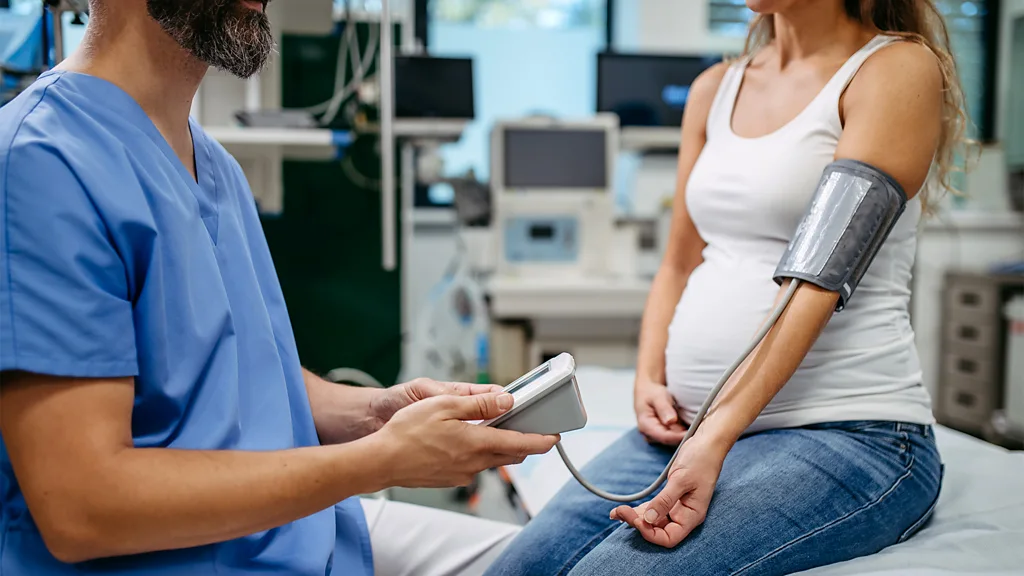Pre-eclampsia: The deadly mystery scientists can't solve

The condition causes more than 70,000 maternal deaths every year – but its causes continue to elude scientists.
After a glittering track and field career which saw her rack up seven Olympic gold medals and 14 world championship golds, Allyson Felix assumed that pregnancy would be as smooth as her trademark running style.
"All my life, I've taken care of my body, my body has been my tool, and it has never really failed me," says Felix. "I've trained and I've put demands on my body, and it's always performed. [So] I was thinking [of having] like a beautiful natural birth, I'd gone to hypnobirthing, and all these things," she says.
But when Felix attended a routine check-up at 32 weeks, she was shocked to be told that she had severe pre-eclampsia, a pregnancy complication that causes dangerously high blood pressure levels and organ damage, and that she required immediate hospitalisation. The following day, doctors performed an emergency C-section, and her daughter Camryn was born two months early, subsequently spending the first month of her life in the neonatal intensive care unit.
Until then, there had been few signs that anything was amiss for Felix and her unborn baby, other than some swelling in her feet. "I wasn't too alarmed by that, but I found out I was spilling protein and all these things about my blood pressure. It was terrifying. But our family got to go home," she says.
While Camryn is now a healthy five year old, Felix is all too keenly aware of similar stories which have resulted in a far more tragic ending. In April 2023, her long-time team-mate Tori Bowie, a former world 100m champion and relay gold medallist at the Rio 2016 Olympics, died in childbirth from complications linked to pre-eclampsia. She was just 32.
"We were on numerous relay teams together, we competed against each other, with each other, and that was extremely shocking," says Felix. "Someone that I've spent so much time with, it was really devastating."
Worldwide, pre-eclampsia is thought to be responsible for more than 70,000 maternal deaths and 500,000 foetal deaths every year, with many fatalities resulting from stroke or prolonged fitting as a result of the elevated blood pressure. It can occur without warning at any time during pregnancy, with some women developing early-onset pre-eclampsia before 34 weeks, and others experiencing late-onset forms of the condition. Women can even suffer from postpartum pre-eclampsia in the six weeks after giving birth.
women developing early-onset pre-eclampsia before 34 weeks, and others experiencing late-onset forms of the condition. Women can even suffer from postpartum pre-eclampsia in the six weeks after giving birth.

Scientists have uncovered a few clues as to why this happens. Excessive inflammation, beginning in the uterus, disrupts the delicate communication patterns taking place between the mother's body and the foetus. In particular, it impacts the reshaping of blood vessels within the uterus to form the placenta, the organ created to provide the foetus with the nutrients and oxygen it needs.
Because the flow of blood through the placenta is abnormal, it ultimately interferes with how the mother's body controls blood pressure, gradually leading to hypertension and ultimately pre-eclampsia.
"When a woman becomes pregnant, her heart's got to pump extra for the baby and the placenta," says Ian Wilkinson, clinical pharmacologist and professor of therapeutics at the University of Cambridge, who is leading a UK-based population study of pre-eclampsia called Poppy. "The amount of blood she's pumping each minute goes up one-and-a-half to two times [in normal pregnancy]."
Women with existing autoimmune disorders, those aged over 40 and women with a larger body mass index are known to be at greater risk, perhaps because they are unable to adapt as well to the physical toll that pregnancy places on a woman's body.
But there are still many mysteries about why certain women develop pre-eclampsia, often without warning, and why others do not. In particular, rates are as much as 60% higher in black women, who are also more likely to experience severe forms of the condition.
Some researchers believe that the latter could be linked to poorer access to good nutrition and health insurance. "There's structural racism, where certain patients and communities don't have the same access to early interventions, detection screening, primarily because of where they get their healthcare," says Garima Sharma, director of cardio-obstetrics and cardiovascular women's health at the healthcare company Inova Health System in Fairfax, Virginia.
At the same time, Sharma says that this does not explain exactly why the condition begins in the first place. While doctors still rely heavily on clinical risk factors such as age, ethnicity and medical history to assess who might develop pre-eclampsia, the accuracy of predictions based on these factors is notoriously poor. "The sensitivity of clinical risk factors on their own is low," says Sharma.
But with newer and improved diagnostics beginning to emerge, scientists may soon be able to shed more light on who is at risk and why.
While specialists treating other diseases such as cancer or chronic infections can often take a biopsy of a patient's internal tissues for further analysis, there is no easy way of studying the changes taking place in a pregnant woman's uterus.
"We can't just routinely go in and collect a sample of placenta [from a pregnant woman], because that can really increase the risk of miscarriage," says Lana McClements, associate professor at the University of Technology Sydney. "And animals actually don't develop pre-eclampsia, so rodent models, for example, are very difficult to create."

Instead, researchers have had to try and pick up abnormal levels of certain molecules in the blood, as a way of detecting that something might be going wrong. In particular, studies have shown that in women with high levels of inflammation in the uterus, placental cells respond to the impaired blood supply by releasing a protein known as soluble fms-like tyrosine kinase 1 (sFlt-1). Once in the bloodstream, excess levels of this protein have a toxic impact, increasing the sensitivity of the fragile barrier between the mother and foetus to inflammation.
"That protein accumulates to about 100 times normal levels in patients who are developing pre-eclampsia," says Craig Mello, a biologist at the University of Massachusetts Medical School who was a co-recipient of the 2006 Nobel Prize for Physiology or Medicine. "So it can be used as a diagnostic prior to the dangers of organ failure that you can get with pre-eclampsia."
Last year, the life science and clinical research company Thermo Fisher Scientific received approval from the US Food and Drug Administration (FDA) regulator for a new diagnostic for pre-eclampsia. The process helps to fast-track the development of medical technologies that treat or diagnose serious conditions. In this case, the diagnostic tool involves looking for high sFlt-1 levels in comparison to low levels of another protein, placental growth factor, which represents normal placental development.
Clinically, the test will be used to quickly predict whether a pregnant woman hospitalised with signs of hypertension will develop severe pre-eclampsia within the next two weeks. Its efficacy was provisionally demonstrated in a 2022 study examining more than 700 pregnant women across 18 different hospitals, in which patients who tested positive were able to receive enhanced surveillance and accelerated care before their symptoms could worsen.
While it's thought that the new diagnostic technique will save lives, Cindy Anderson, professor of maternal infant health at the Ohio State University College of Nursing, feels that there remains a need for more advanced diagnostics which can detect warning signs of pre-eclampsia at a much earlier stage in pregnancy. If the tentative hints of pre-eclampsia could be identified at a point where the placenta is not fully developed, and it might still be possible to prevent the condition.
"After nine weeks the placenta has developed," says Anderson. "So can we see these signals earlier, and could we then intervene with a treatment to either halt it or even cure it?"
To try and enable this, a group of scientists are turning to a new technology, one which has evolved at a rapid pace within the last few years.
In a lab in Sydney, McClements and her team are painstakingly assembling layers of living placental cells, connected with supporting gels, to create natural tissue-like structures. Their idea is to model some of the processes which might take place in the earliest stages of pre-eclampsia, outside of the human body, something which has never been done before. The team have affectionally dubbed the technology "placenta on-a-chip".
"We've been trying to develop these models that can mimic what's happening in the human placenta in pre-eclampsia conditions," says McClements. "For example, we've used trophoblasts, the layers of cells which direct the formation of the placenta, from the first trimester. We're trying to understand what's happening to them under the conditions of inflammation, oxidative stress, lack of oxygen and restricted blood vessel development, which precede pre-eclampsia early in pregnancy," she says.
According to McClements, the hope is that one day this research could yield new biomarkers which could form the basis of future blood tests for newly pregnant mothers. But having a more realistic model of pre-eclampsia could also make it easier for researchers to test potential therapies, ones which might actually alter the course of the disease.
"Two-out-of-three women who have gone through pre-eclampsia in pregnancy will die prematurely from heart attacks and cardiovascular disease," says McClements. "So there's a real need to find new treatments to prevent both pregnancy and post-pregnancy disease."
To date, the only recommended therapy for pregnant women deemed to be at high risk of pre-eclampsia is low dose aspirin from 12 weeks until birth. Studies have shown that an estimated 60% of women who begin aspirin therapy before week 16, do not develop any symptoms of pre-eclampsia.
But this still leaves 40% of patients who remain vulnerable, along with many who do not receive it at all because their doctors did not suspect them to be vulnerable to pre-eclampsia. "There are many who don't get it, and it's not even discussed with them," says Andrew Shennan, professor of obstetrics at King's College London.

McClements explains that drug repurposing, the process of finding new uses for existing or abandoned medications which are known to be safe for pregnant women, has great potential for improving pre-eclampsia care, a process which could be accelerated by testing such medicines on bioprinted placental cells.
Proton pump inhibitors, drugs widely used to treat indigestion, heartburn or stomach ulcers, are thought to be possibly capable of reversing some of the damaging inflammatory processes which drive the initial stages of pre-eclampsia. Researchers have also suggested that eculizumab, a monoclonal antibody used to treat a form of blood disease, may be able to reduce the risk of pre-eclampsia development if administered at the beginning of pregnancy.
"We're currently honing in on metformin, a diabetes drug which is emerging as a potential treatment," says McClements. "There's a fascinating study, which showed that metformin can actually delay delivery of the baby in early severe pre-eclampsia, so it can potentially prevent preterm birth."
Another approach involves attempting to halt the condition in its tracks by preventing the production of sFlt1 in the placenta. Last year, the FDA cleared a new investigational drug called CBP-4888, which has been developed by a Massachusetts-based company called Comanche Biopharma, for testing in clinical trials. The drug is known as a small interfering RNA (siRNA), short pieces of genetic code which can be precisely directed to various parts of the body where they can regulate gene expression and cellular function to halt production of a particular protein, in this case sFlt1.
"One of the remarkable things about these molecules is their longevity, says Mello, who is working as a scientific advisor to Comanche BioPharma. "A single dose can last for periods of six months to a year. So we would expect one dose to be sufficient."
So far, the company has completed testing the safety of the drug in female volunteers of childbearing age. As a next step, they are aiming to test it in a further trial of approximately 50 pregnant women with pre-eclampsia, potentially followed by wider studies in the US and possibly even the UK, Australia, Germany, Ghana, Kenya, and South Africa.
"Women of colour have a disproportionate burden of pre-eclampsia," says Allison August, chief medical officer of the biopharmaceutical company Comanche Biopharma. "So when we do our studies in the US, we're going to go to centres in the south side of Chicago, Alabama, St Louis, places where we know that the population has a disproportionate burden of pre-eclampsia. Because that's a subset of the population that has extreme need."
While McClements is encouraged by some of the advances which have been made, she hopes that more investment will be directed towards pre-eclampsia research in future, given the substantial and often underrecognised impact it has on the population.
"If you compare how much funding goes into cancer, women's health is just 1-2% of that," says McClements. "But ultimately, we all come from pregnancy. Women are half of the population but also mothers to the other half. And we know that being born to a mother who has had pre-eclampsia, has an impact on the long-term health of babies. So there's a need to find solutions."
Source: BBC
















































:max_bytes(150000):strip_icc():format(webp)/Health-GettyImages-1318964026-4c79c2495e9146d483909fe539e09347.jpg)







